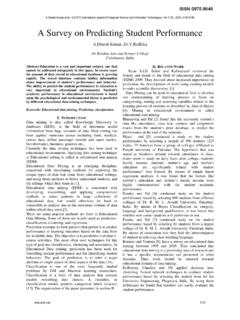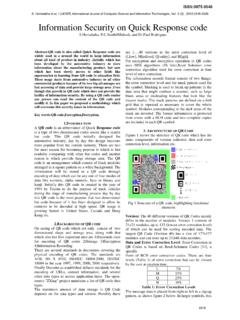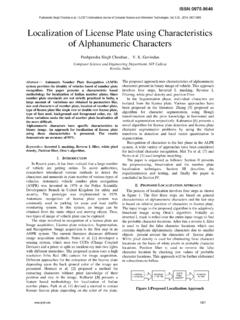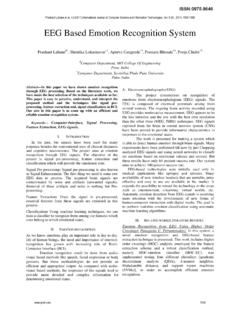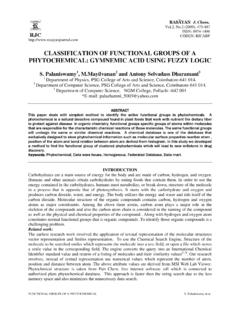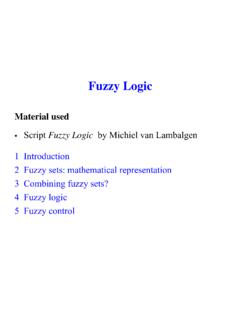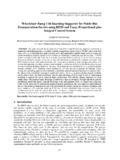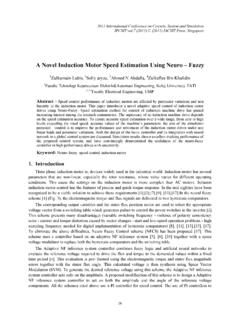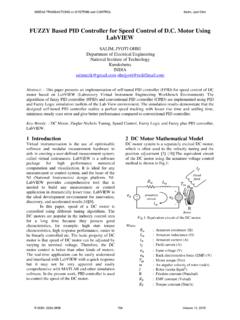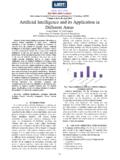Transcription of Intrusion Detection System using Genetic-Fuzzy …
1 Intrusion Detection System using Genetic-Fuzzy classification Prabhat Prakash1, Dr. Rajendra Kumar Bharti2 Computer Science & Engineering Department, Bipin Tripathi Kumaon Institute of technology Dwarahat, Uttarakhand, India Abstract Intrusion Detection System has become the prime focus in the area of network security research. An effective Intrusion Detection System must detect the previously known attacks as well as variations of known attacks and unknown attacks. The challenging and critical problem in Intrusion Detection is the classification of Intrusion attacks and normal network traffic. fuzzy systems have been used to solve several classification problems. Genetic-Fuzzy systems hybridize the approximate reasoning method of fuzzy systems with the learning capability of evolutionary algorithms.
2 In this paper a novel Intrusion Detection method is presented, capable of detecting normal and intrusive behaviours, which extracts both accurate and interpretable fuzzy IF-THEN rules from network dataset for classification . This method uses the fuzzy association rule based classification method for high dimensional problems based on three stages to obtain an accurate and compact fuzzy rule based classifier with a low computational cost. Experiments were performed with KDD-cup 99 dataset, which contains information of computer networks, during normal and intrusive behaviours. The result of the proposed Intrusion Detection model is compared with some well-known classifiers.
3 Keywords Intrusion Detection , Genetic-Fuzzy rule based classification , fuzzy association rules, KDD-cup 99. I. INTRODUCTION Intrusions refer to the actions; attempt to compromise the integrity, confidentiality or availability of a resource [1]. It is the act of a person or proxy attempting to break into or misuse one s System in violation of an established policy. Intrusions result in services being denied, System failing to respond, data stolen or being lost. Intrusion Detection means detecting unauthorized use of a System or attacks on a System or network. An Intrusion Detection System monitors and restricts user access to the computer System by applying certain rules.
4 Based on analysis strategy, Intrusion Detection System is categorized into misuse and anomaly IDS. When the IDS looks for events or sets of events that match a predefined pattern of a known attack, this analysis strategy is called misuse Detection . The effectiveness of misuse IDS is largely based on the validity and expressiveness of their database of known attacks and misuse, and the efficiency of the matching engine that is used. The disadvantage of misuse IDS is that it requires frequent updates to keep up with the new stream of vulnerabilities discovered and it cannot detect unknown attacks. When the IDS identifies intrusions as unusual behaviour that differs from the normal behaviour of the monitored System , this analysis strategy is called anomaly Detection .
5 Anomaly Detection approaches attempt to build some kind of a model over the normal data and then check to see how well new data fits into that model. In other words, anything that does not correspond to a previously learned behaviour is considered intrusive. Therefore, the Intrusion Detection System might not miss any attack, but its accuracy is a difficult issue, since it can generate a lot of false alarms. One of the most effective methods to automate and simplify the development of Intrusion signatures, and to predict novel attacks is learning classification rules from network data, if the generalized knowledge can be extracted from data. fuzzy rule based classification systems (FRBCSs) are well known tools in the machine learning framework, since they can provide interpretable model [2].
6 Association discovery is one of the most common data mining techniques which are used to extract relationships between different items in a large dataset [3]. It has been used for classification under the name of associative classification [4]. genetic algorithms have been used for rule generation and optimization methods in the design of fuzzy rule based classifier [5]. The genetic algorithm based design of FRBCSs is usually referred as GFRBCSs. Genetic-Fuzzy rule based classification and data mining have been used previously to solve the Intrusion Detection problem. In [6], a data mining framework is proposed for constructing Intrusion Detection models. In [7], a prototype IIDS (Intelligent Intrusion Detection System ) is proposed, which is both anomaly and misuse detector.
7 The anomaly-based components are developed using fuzzy data mining techniques. The method EFRID, proposed in [8], classifies the System behaviour by fuzzy rules. In [9], a multi-objective genetic fuzzy Intrusion Detection System (MOGFIDS) is proposed which applies an agent-based evolutionary computation framework to generate and evolve an accurate and interpretable fuzzy knowledge base for classification . In [10], authors proposed a novel fuzzy method with genetic algorithm for detecting Intrusion data from the network database. In this approach GA is implemented using directed graph structures instead of strings in genetic algorithm or trees in genetic programming, which leads to enhancing the representation ability with compact programs derived from the reusability of nodes in a graph structure.
8 In [11], the IDS uses fuzzy association rules for binding fuzzy classifiers. In this method an immune-inspired algorithm is proposed for mining fuzzy Prabhat Prakash et al, / (IJCSIT) International Journal of Computer Science and Information Technologies, Vol. 5 (6) , 2014, rule set, in which the fuzzy sets corresponding to each attribute and the final fuzzy rule set can be directly extracted from a given dataset. In [12], a hybrid fuzzy genetic rule based inference engine has been designed. The fuzzy logic constructs precise and flexible patterns while the GA helps in attaining optimal solution. This paper presents an approach to IDS using Genetic-Fuzzy rule based System and association discovery.
9 The experiments were performed out on KDD-cup 99 dataset [13] and the results were compared with some well-known IDS classifiers. II. PRELIMINARIES This section discusses fuzzy rule based classification systems and fuzzy association rules for classification . A. fuzzy Rule Based classification Any classification problem consists of N training patterns, , xp = (xp1, .. ,xpm ), p = 1, 2, ..,N; from S classes, where xpi is the ith attribute value (i = 1, 2, ..,m) of the pth training pattern. fuzzy rule of the classifier is of the following form: Rule Rj: IF x1 is Aj1 and and xm is Ajm THEN Class = Cj with RWj where, Rj is the label of the jth rule, x = (x1, .. , xm) is an m-dimensional pattern vector, Aji is an antecedent fuzzy set, Cj is a class label, and RWj is the rule weight.
10 The performance of fuzzy rule-based classifiers depends on the rule weight of each fuzzy rule Rj [14]. The most common rule weight is the fuzzy confidence value or certainty factor (CF) [15]. = = (1) where, is the matching degree of the pattern xp with the antecedent part of the fuzzy rule Rj. fuzzy reasoning method of the weighted vote or additive combination is used to classify new patterns by the rule base [16]. With this method, each fuzzy rule casts a vote for its consequent class. The total strength of the vote for each class is computed as follows: = . ; (2) The new pattern xp is classified as the class with the maximum total strength of the vote.




